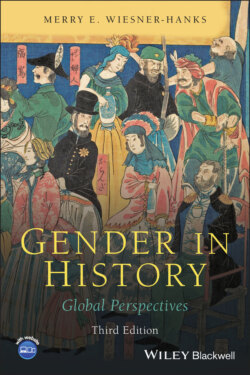Gender in History

Реклама. ООО «ЛитРес», ИНН: 7719571260.
Оглавление
Merry E. Wiesner-Hanks. Gender in History
GENDER IN HISTORY
Contents
List of Illustrations
Guide
Pages
List of Figures
Acknowledgments
About the Companion Website
CHAPTER ONE Introduction
Women’s and Gender History
World and Global History
Gender, Sex, and Sexuality
Difference and Intersectionality
Theory in History
Gender History as a Field
Structure of the Book
Further Reading
Notes
CHAPTER TWO Ideas, Ideals, Norms, and Laws
The Nature and Roles of Men and Women
Binaries
Motherhood and Fatherhood
Ideologies, Norms, and Laws Prescribing Gender Inequity
Ideologies of Egalitarianism
Further Reading
Notes
CHAPTER THREE Early Human History (to 3000BCE)
Early Hominids
Homo Sapiens
Paleolithic Society and Spirituality
Domestication
Agricultural Societies
The Origins of Patriarchy
Further Reading
CHAPTER FOUR Ancient Cities and States (3000BCE–600BCE)
Cities and Social Hierarchies
Writing
Families and Households
Work
Religions in the Ancient Near East
Hereditary Dynasties and Female Rulers
Further Reading
Notes
CHAPTER FIVE Classical Cultures (500BCE–500CE)
Family Life in the Classical Cultures of Eurasia
Sexuality in Classical Eurasia
Philosophy and Religion in East Asia: Confucianism and Daoism
Religious Traditions of South Asia: Hinduism and Buddhism
Religious Traditions in the Mediterranean: Christianity
Education and Culture
Further Reading
Notes
CHAPTER SIX The Middle Millennium (500CE–1500CE)
Families, Households, and Kin in Africa, the Americas, and the Pacific
Religious Traditions Transmitted Orally
State-Based Societies in the Americas
Courts and Courtly Culture
The Rise and Spread of Islam
Europe and the Mediterranean
Cities and the Gendering of Work
Further Reading
Notes
CHAPTER SEVEN The Early Modern World (1500CE–1800CE)
Economic Developments
The Renaissance
Religious Transformations
Families and Race
Representations of Conquest and Colonialization
Women and Politics
Further Reading
Notes
CHAPTER EIGHT The Modern World (1800CE–2021CE)
Industrialization
Imperialism
Nineteenth-century Movements for Social Change
Modern Sexuality
Wars, Revolutions, and Political Change
The Industrial and Postindustrial Economy
Families in the Twentieth and Twenty-first Centuries
Cultural Changes in the Twentieth and Twenty-first Centuries
Further Reading
Afterword
Further Reading
Index
WILEY END USER LICENSE AGREEMENT
Отрывок из книги
Global Perspectives
Third Edition
.....
The history done in any country, not simply Brazil and Hungary, is shaped by regional and world politics, and issues other than gender have often seemed more pressing to historians in Latin America, Eastern Europe, and other parts of the world where political and economic struggles have been intense. Universities and researchers in developing countries also have far fewer resources, which has hampered all historical research and limited opportunities for any new direction. Thus an inordinate amount of the work in the history of women, gender, and sexuality, including that which focuses on the continent of Europe and many other parts of the world, has been done by English-speaking historians, and the amount of research on English-speaking areas far outweighs that on the rest of the world. There is also imbalance within English-speaking areas, for studies of the United States vastly outnumber those of anywhere else.
There are signs that this imbalance is changing somewhat, as organizations to promote the history of women, gender and sexuality, and academic women’s/gender/sexuality studies programs are gradually being established in more countries, sometimes at great risk to those who organize them. Yet the head start of English-language scholarship, combined with the ability of many students and scholars throughout the world to read English – and the inability of many English-speaking students and scholars to read anything but English – have meant that the exchange of theoretical insights and research results has to this point been largely a one-way street.
.....